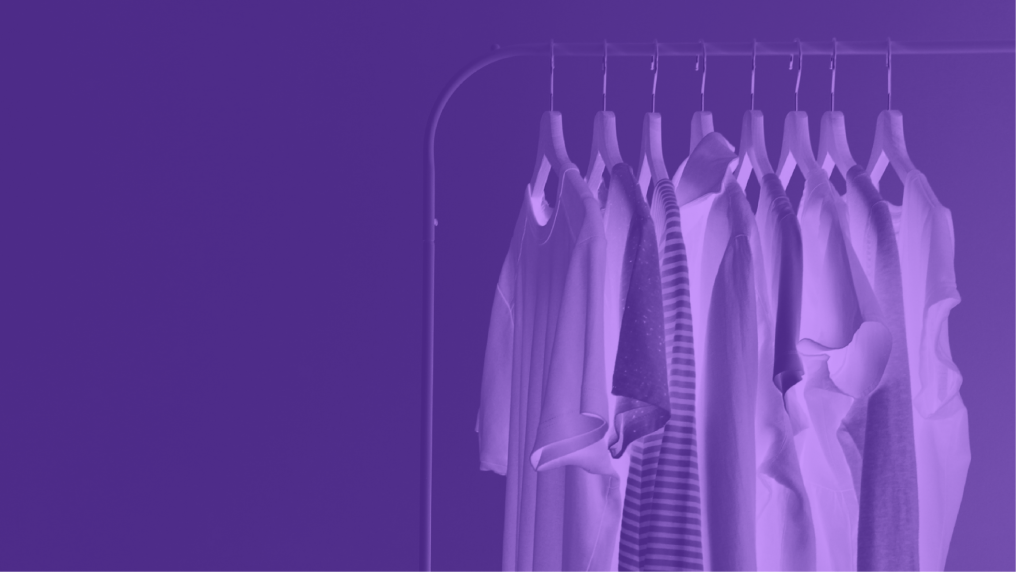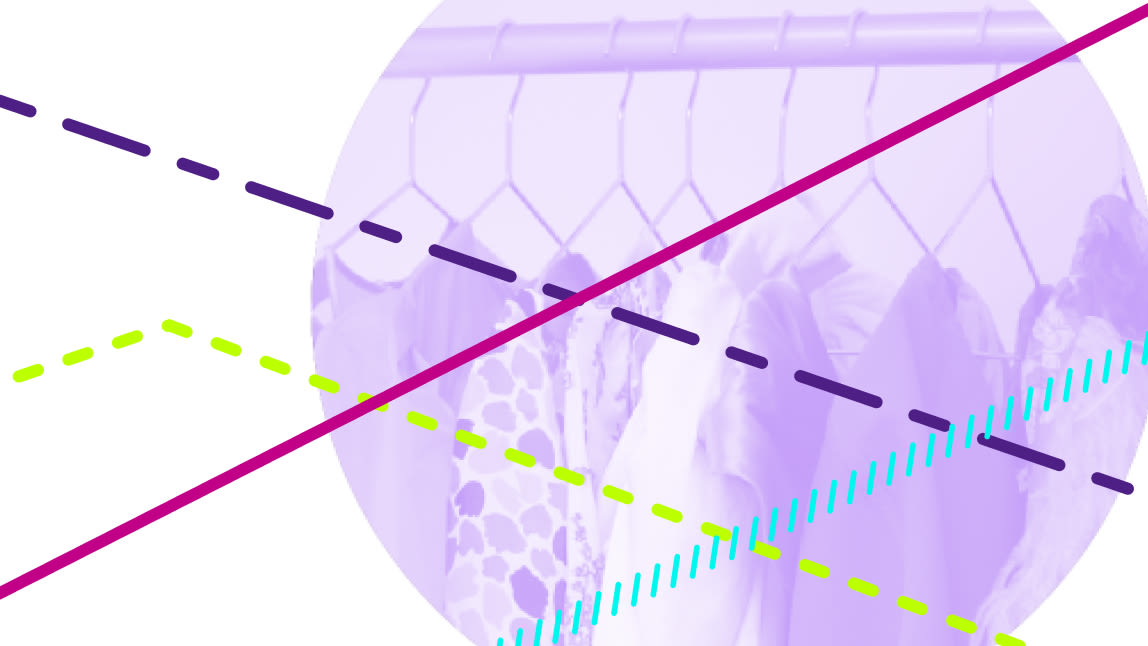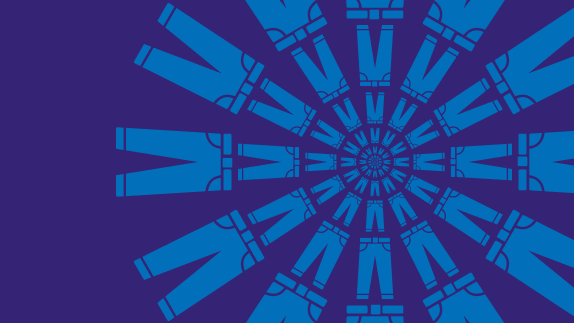Textiles and clothing are a fundamental part of everyday life and an important sector in the global economy.
This deep dive explores how the principles of the circular economycircular economyA systems solution framework that tackles global challenges like climate change, biodiversity loss, waste, and pollution. It is based on three principles, driven by design: eliminate waste and pollution, circulate products and materials (at their highest value), and regenerate nature. can be applied to the fashion industry, beginning by covering why the fashion industry of today is not fit for purpose. Following that, it examines the vision for a new global textiles system through three focus areas that are critical to realising this vision:
New business models that increase clothing use
Safe and renewable inputs
Solutions so used clothes are turned into new
Finally, you will learn about the opportunities that exist for innovative business models that can be employed by the fashion industry, including clothing rental, increased durabilitydurabilityThe ability of a product, component or material to remain functional and relevant when used as intended., and boosting clothing care.

The fashion industry of today
Changing the system will unlock billion dollar economic opportunities. Globally, the USD 1.3 trillion clothing industry employs more than 300 million people along the value chain; the production of cotton alone accounts for almost 7% of all employment in some low-income countries.
Clothing represents more than 60% of the total textiles used and in the last 15 years, clothing production has approximately doubled, driven by a growing middle-class population across the globe and increased per capita sales in mature economies. At the same time, clothing use has declined by almost 40%. Both developments are mainly due to the ‘fast fashion’ phenomenon, with quicker turnaround of new styles, increased number of collections offered per year, and often, lower prices.
By moving to a circular system the industry can unlock a USD 560 billion economic opportunity. Realising this opportunity requires new business models and collaboration across the value chain (e.g. production, marketing, and after-sales care), to keep safe materials in use.
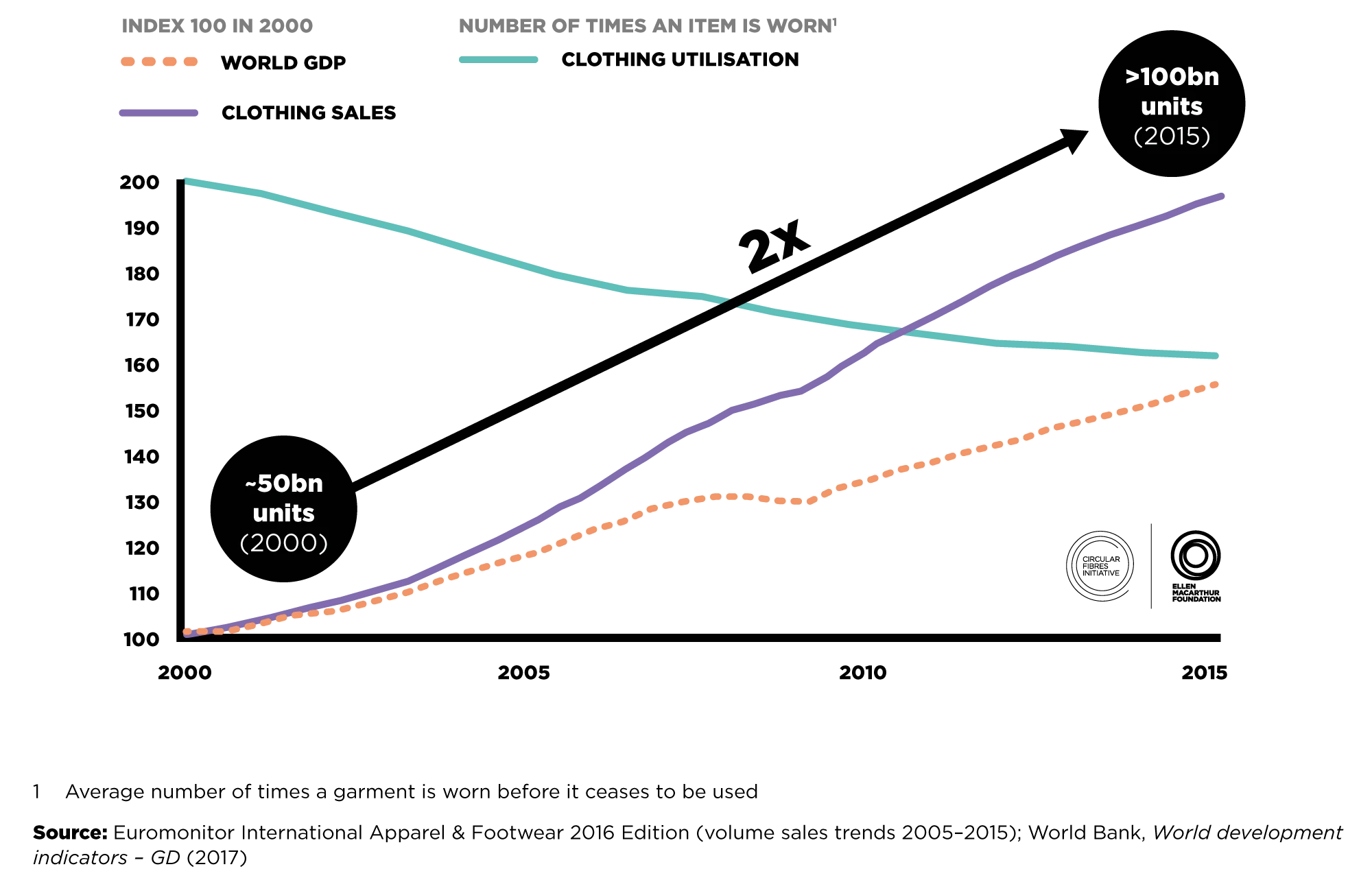
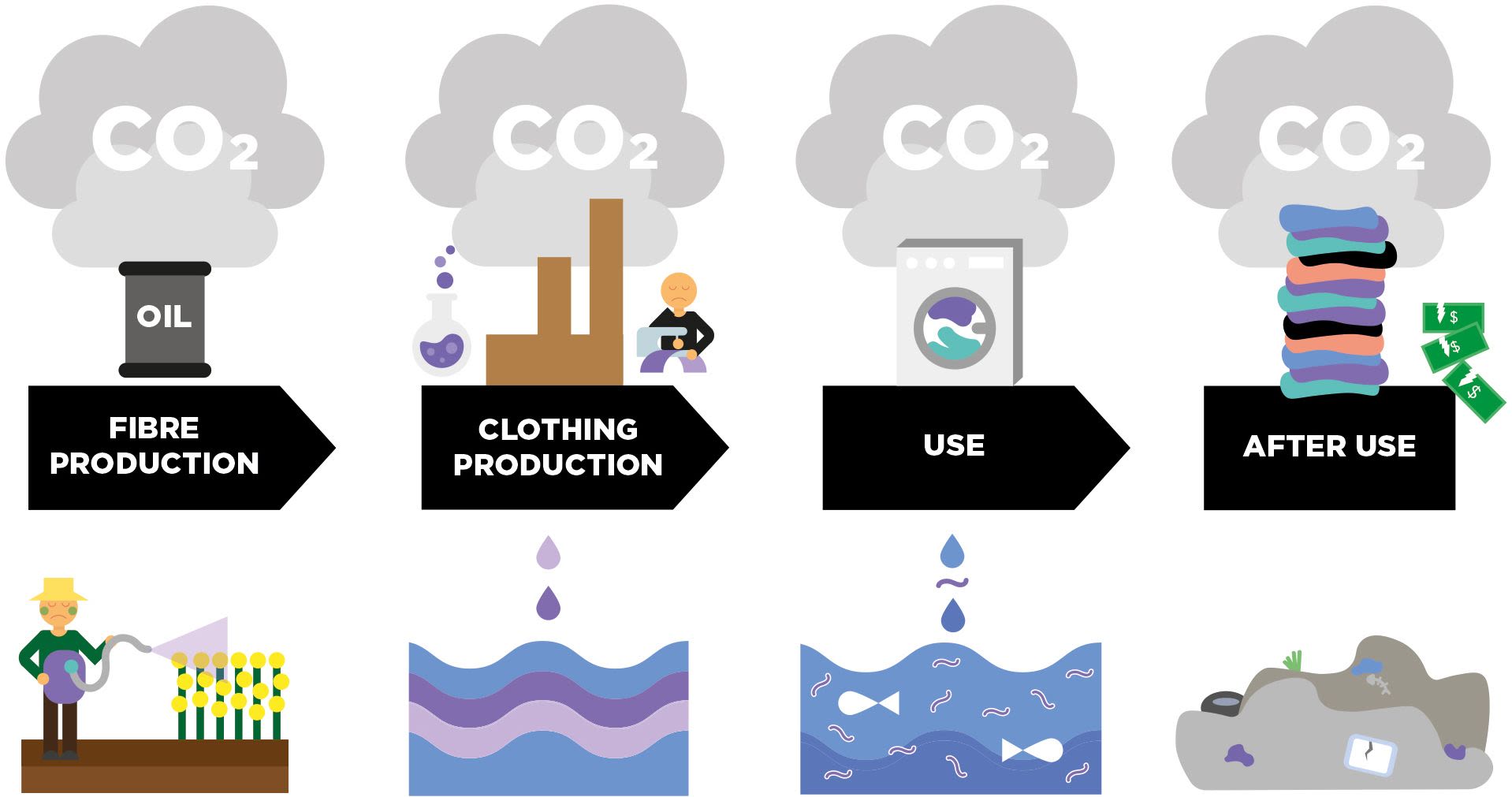
Why the current clothing system doesn't work
Every second one truckload of clothing is landfilled or burned.
The current system for producing, distributing, and using clothing operates in an almost completely linear way. Large amounts of nonrenewable resources are extracted to produce clothes that are often only used for a short period, after which the materials are largely lost to landfill or incineration. It is estimated that more than half of fast fashion produced is disposed of in under a year.
This linear system leaves economic opportunities untapped, puts pressure on resources, pollutes and degrades the natural environment and its ecosystems, and creates significant negative societal impacts at local, regional, and global scales.
Key issues currently within the industry:
Clothing is massively underutilised
While many low-income countries have a relatively high rate of clothing utilisation, elsewhere rates are much lower. In the US, for example, clothes are only worn for around a quarter of the global average. Globally, customers miss out on USD 460 billion of value each year by throwing away clothes that they could continue to wear, and some garments are estimated to be discarded after just seven to ten wears.
An immense footprint
The textiles industry relies mostly on non-renewable resources – 98 million tonnes in total per year – including oil to produce synthetic fibres, fertilisers to grow cotton, and chemicals to produce, dye, and finish fibres and textiles. With its low rates of use (leading to high levels of throughput) and low levels of recycling, the current wasteful, linear system is the root cause of this massive and ever-expanding pressure on resources. The industry’s immense footprint extends beyond the use of raw materials.
Catastrophic potential
If the fashion industry continues on its current path, by 2050 it could use more than 26% of the carbon budget associated with a 2C global warming limit. Moving away from the current linear and wasteful textiles system is therefore crucial to keep the 2C average global warming limit within reach.
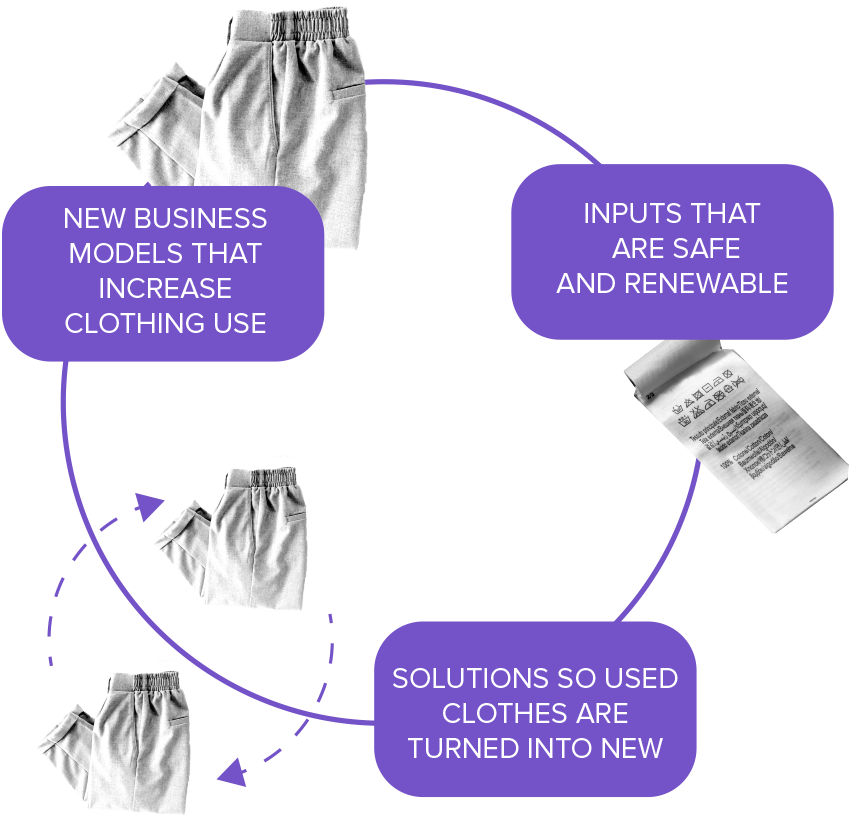
The vision of a circular economy for fashion
Creating business models which are restorative and regenerative.
The overarching vision of a circular economy for fashion is one that is restorative and regenerative by design and provides benefits for business, society, and the environment. In such a system, clothes, textiles, and fibres are kept at their highest value during use and re-enter the economy after use, never ending up as waste. A circular economy for fashion is an attractive vision of a system that works
Realising this vision of a new global textiles system relies on three focus areas:
New business models that increase clothing use
Safe and renewable inputs
Solutions so used clothes are turned into new
Such a system would have the following characteristics...
1. It produces and provides access to high quality, affordable, individualised clothing
In a circular economy for fashion, everyone has access to the clothes they need, when they need them. New business models give customers more flexibility on the clothes they’d like to wear and provide access to clothes that might not be affordable through traditional sales. Clothes are designed and produced at a high quality, are durable, and provide different functionalities and flexibility – for example, in the form of personal styles, customised or modifiable clothes.
2. It captures the full value of clothing during and after use
In a circular economy for fashion, clothes are used more often, which allows their value to be captured fully. Once clothes cannot be used anymore, recycling them into new clothes allows the value of the materials to be captured at different levels. To be able to capture the value of all materials once garments are no longer worn, it is necessary to ensure that design aligns with recycling processes that are available today.
3. It runs on renewable energy and uses renewable resources where their input is needed
The energy required to fuel a circular economy for fashion is renewable, decreasing resource dependence and increasing system resilience. Resources are kept in the system and where input is needed, this comes from renewable resources. This means using renewable feedstock for plastic-based fibres and not using fossil-fuel-based fertilisers or pesticides in the farming of biologically-based input. A circular economy for fashion further enables this shift to renewables as its very nature ensures that less energy and fewer resources are consumed.
4. It reflects the true cost (environmental and societal) of materials and production processes in the price of products
In a circular economy for fashion, the price of clothing reflects the full costs of its production, including negative environmental and societal impacts. Such costs are first analysed and presented in company reporting, and ultimately reflected in product prices.
5. It regenerates nature and does not pollute the environment
Renewable resources are extracted from nature by regenerative and restorative methods that rebuild natural capital (the world’s stock of natural resources). This means using regenerative agriculture for biological-based input such as cotton, and sustainably managed forests for wood-based fibres. Substances of concern do not leak into the environment or risk the health of textile workers and clothing users. Plastic microfibres are not released into the environment and ocean. Other pollutants, such as greenhouse gases, are designed out.
6. A circular economy for fashion is distributive by design
As part of promoting overall system health, a circular economy for fashion presents new opportunities for distributed and inclusive growth. It creates a thriving ecosystem of enterprises from small to large, retaining and then circulating enough of the value created so that businesses and their employees can participate fully in the wider economy.

Develop business models that keep clothes in use
Ensuring clothing is durable not disposable.
Designing and producing clothes of higher quality and providing access to them via new business models would help shift the perception of clothing from a disposable item to a durable product. There are numerous opportunities for innovative business models to be employed by the fashion industry, including subscription services, clothing rental, and peer-to-peer sharing.
The following sections delve into detail on some of these opportunities.
Clothes rental models
Rental models can provide customers with access to a variety of clothes while decreasing the demand for new clothing production.
Short-term rental models offer a compelling value proposition, particularly when taking changing customer needs into consideration - examples include short term use, practical requirements, or fast evolving fashion preferences.
New short-term and subscription rental models are already emerging within the industry. We have started seeing examples of specialised garments such as MUD Jeans offering high-quality denim, Vigga offering subscription for baby wear, Rent the Runway targeting working women and offering an ‘unlimited’ subscription service.
Listen to an interview with Vigga:
Make durability more attractive
The case for new business models improves when clothes are of high-quality and durable.
This is because rental or resale models increase. Customers often value high-quality, durable clothes but a lack of information often prevents them from making the best choices. Quality purchases encourage the use of new technologies that provide customisation for maximum customer satisfaction. For clothes that become unwanted but are still usable, enhanced resale models offer an attractive opportunity. For customers who want to retain their clothes for longer, appropriate care should be encouraged and facilitated.
Currently, there are no industry standards to assess garment durability. Transparency could be created through clear and aligned quality labelling or guarantees. Quality is of particular interest in wardrobe ‘essentials’ and ‘staples’ which include coats, jumpers, jeans, t-shirts, socks, hosiery, and underwear, representing 64% of garments produced globally for both women and men. Many customers expect these items to last and often wear them until they have a material flaw, hard-to-remove stains, or have lost colouration.

Make resale attractive to a wide range of customers
Designing clothes to last and creating innovative resale models.
As the average quality and durability of clothing on the market increases, so will the opportunity of capturing its value through new business models. Clothing resale is already widely adopted across the world. The latest figures from the ThredUp Resale report 2019 show that resale has grown 21 times faster than retail over the past five years. In fact, 56 million women bought second-hand products in 2018, up from 44 million in 2017. Therefore, if clothes are increasingly made to last, introducing attractive resale models suited to a wider customer base locally (i.e. in the same countries where clothes are being discarded) could significantly increase clothing utilisation. To achieve this, innovative resale models, partnerships, and the harnessing of digital technology are all required. Stella McCartney’s ongoing partnership with the Real Real and the Reformation partnership with ThredUp are examples of successful collaborations.
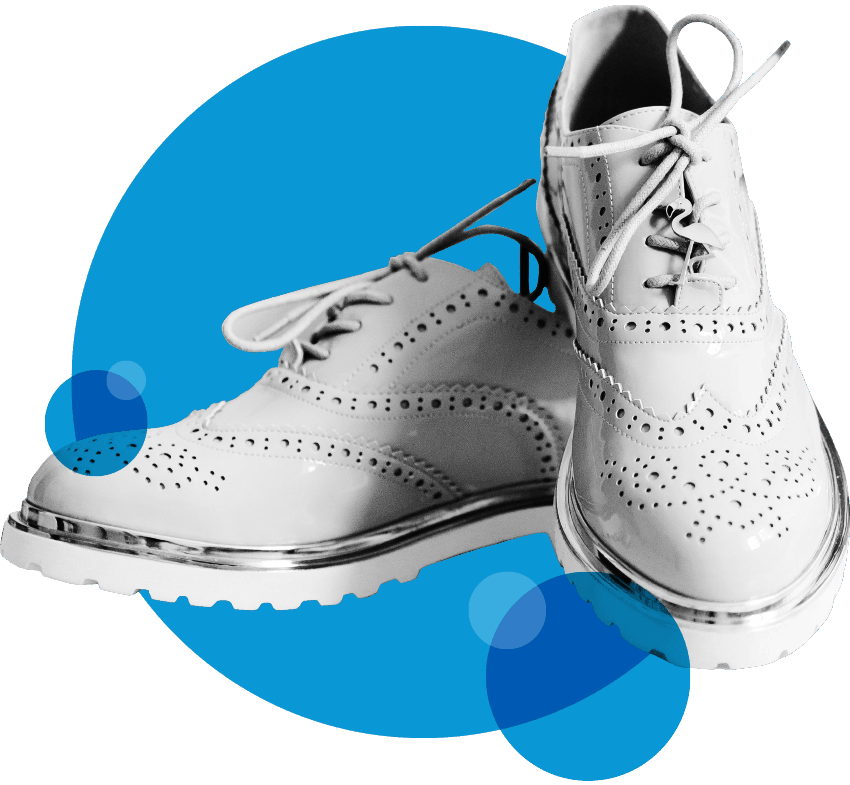
Boost clothing care
Support the efforts of customers to maintain their clothes for longer.
Accessible services and widespread support for users to maintain their clothes for longer (e.g. through repair, restyle, washing, and storing) could help to keep clothes at their highest perceived and actual value. Clothes that hold high physical and emotional durability would in turn increase demand for repair services. This could open up opportunities to introduce more clothing services, such as garment restyling or consulting, advice on upgrades, customisation, and mending at home. Retailers could provide repair and other services in-store and form partnerships with repair and restyle providers based in local communities. Several brands already offer in-store repair and incentivise users to keep their garments well maintained, in particular, outdoor clothing brands such as Bergans, Jack Wolfskin, Patagonia, Salewa, and Houdini, all offer repair services for their used products. Patagonia operates the largest (and still growing) repair facility in North America, repairing about 50,000 pieces per year.

Pause for thought
What actions can you take, as an individual, to contribute to the creation of a circular economy for fashion that is based on the principles of circularity?
The role of the individual
What actions can the individual take to help make fashion circular?
In this video, Francois Souchet – former lead of the Ellen MacArthur Foundation’s Make Fashion Circular initiative – describes some of the ways that changing mindsets can contribute to the creation of a circular fashion system. To learn more visit Google’s Your Plan, Your Planet tool.
The fashion industry of the future
By adopting new business models and designing out waste from the offset, today’s fashion industry has the potential to unlock billion dollar economic opportunities across the globe.
Visit our fashion topic area if you’re keen to learn more about fashion and the circular economy and to dig deeper into the findings of the New Textile Economy report.
-----------------------
Funded by Eric and Wendy Schmidt Fund for Strategic Innovation

